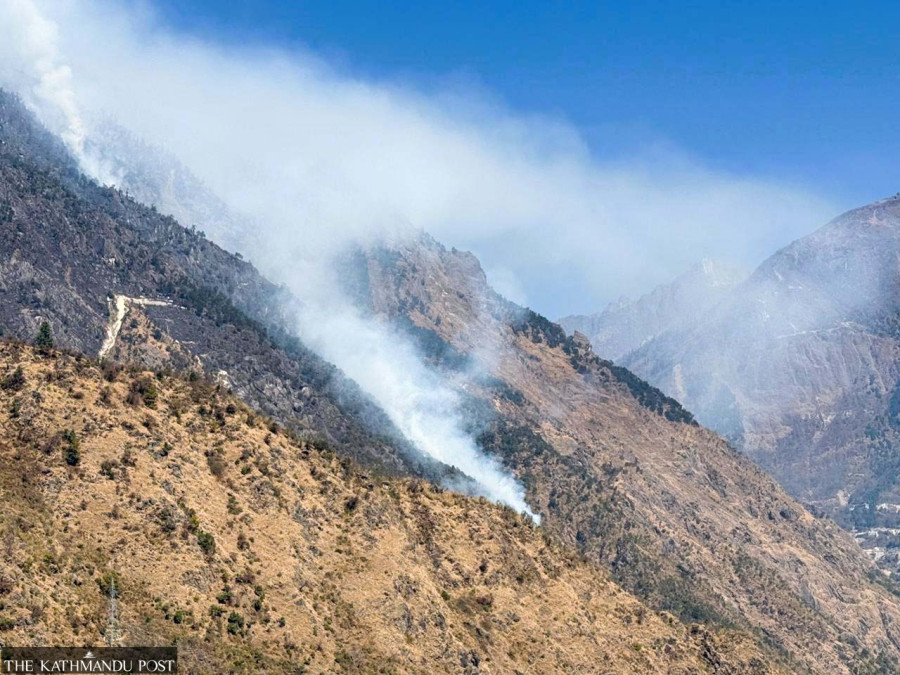Climate & Environment
Raging wildfires drive pollution surge in Kathmandu
Kathmandu Valley ranked the world’s most polluted city on Monday afternoon, with PM2.5 levels reaching 365 micrograms per cubic metre (μg/m3).
Arjun Poudel
Amid widespread wildfires raging across the country, the Kathmandu Valley ranked the world’s most polluted city on Monday afternoon, with PM2.5 levels soaring to 365 micrograms per cubic metre (μg/m3), the hazardous level.
The alarming spike in air pollution could further exacerbate the spread of viral influenza and other health issues, including pneumonia, cough and viral fever, doctors warn.
According to IQAir, a Swiss group that collects air-quality data from around the world, the air quality in Boharatar in Kathmandu soared to a hazardous 365 micrograms per cubic metre. Bhaisepati of Lalitpur recorded 333 micrograms per cubic metre. Air quality in several other locations of the Valley, including Shankharapur, Adhikarigaun, Chagunarayan, Sudal, Tathali, Jawalakhel, and others, crossed 200 micrograms per cubic metre (μg/m3).
PM2.5 refers to particulate matter (solid or liquid droplets) in the air less than 2.5 micrometers in diameter. It is among the most dangerous pollutants that can get past the nose and throat to penetrate the lungs and even the bloodstream. PM2.5 particles are small and are also likely to stay suspended in the air for a long time, increasing the chances of people inhaling them.
As per the Environmental Protection Agency’s air quality index, an air quality reading of 151–200 is considered unhealthy; everyone may experience problems, with sensitive groups feeling more severe effects. When air quality reaches 201-300, it is considered a very unhealthy level, and health risks increase for everyone in the area. When it crosses 300, it comes under the hazardous level, meaning that air quality is extremely poor, which poses serious health risks to everyone.
The rampant wildfire incidents in dozens of places in multiple locations, including Chure forests, along with stubble burning, burning of other waste materials, house fires, and brick kiln operations, are blamed for the deteriorating air quality in the Valley.
“March, April and May are the peak forest fire seasons, and these forest fires not only destroy our valuable forests but also worsen air quality,” said Bhupendra Das, an air quality expert. “Our farmers also burn crop residue, and polluted air also comes from across the borders.”
He said that the lack of rainfall for a prolonged period will certainly lead to more forest fire incidents in the coming days, but responsible agencies remain unprepared to prevent such incidents.
“It's just the start, as the worst is yet to come,” warned Das.
Wildfires are common during the dry season in Nepal, peaking between April and May. They spread across hundreds of forests throughout the country, including in community-protected areas. However, not all of them make it to government records.
“Recent arson incidents in the Valley also contributed to the worsening air quality,” said Deepak Gyawali, spokesperson of the Department of Environment.
Experts say open fires and wildfires emit particulate matter, nitrogen oxides, carbon monoxide, sulfur dioxide, lead, mercury and other hazardous pollutants, which cause both short and long-term health consequences.
Doctors say deteriorating air quality has a serious impact on public health. According to them, poor air quality causes both short- and long-term effects on public health. Bad air quality can cause pneumonia, bronchitis, conjunctivitis, skin allergy, stroke and heart problems, among others, in the short term, ulcers and cancer of the lungs and intestine, kidney disease and heart problems in the long run.
“Cases of viral influenza from winter have not lessened yet, and now, as pollution levels rise, cases of viral influenza have started to spike again,” said Dr Raju Pangeni, a pulmonary and critical care physician at HAMS Hospital. “This year, patients are suffering from prolonged coughs, which take months to cure. The severity of cases has also increased, which forced patients to seek intensive care.”
Experts say polluted air affects all, and those already having health issues, especially respiratory illness, are highly vulnerable.
“Wear a face mask while going out, maintain distance and pay attention to personal hygiene,” advised Dr Niraj Bam, associate professor at the Tribhuvan University Teaching Hospital. “Influenza is like coronavirus, so follow all the basics that were asked to be followed during the pandemic.”
Experts point to the authorities’ apathy to enforcing measures to improve air quality as a key factor in the worsening pollution levels. Worsening air quality has not only affected people’s health, but also hit the economy and hindered overall development. Polluted air has long been taking a huge toll on public health in Nepal, but what’s alarming is that the authorities have not taken the issue seriously, according to experts.
Polluted air has been cutting short the lives of Nepali people by around five years, according to a report by the Air Quality Life Index (AQLI) that converts air pollution concentration into impact on life expectancy. AQLI is a metric produced by the Energy Policy Institute at the University of Chicago.




 29.12°C Kathmandu
29.12°C Kathmandu











